Domestic and Family Violence (DFV) is a serious and widespread problem in Australia. It occurs in all communities, including communities of faith. Victims are predominantly women and children.
Churches can provide trusted relationships and various forms of support – pastoral, material, spiritual – to those who are experiencing violence, or who have previously experienced it. Clergy, leaders and friends at church may be called on by attenders for help.
Most Anglican clergy have experience with domestic and family violence situations. Results from the 2016 National Church Life Survey show how they have responded.
Most Anglican clergy have dealt with DFV situations
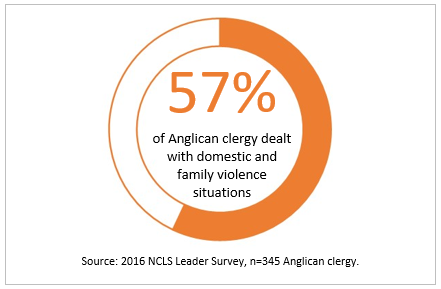
Anglican clergy have mainly responded to victims of abuse, rather than to perpetrators
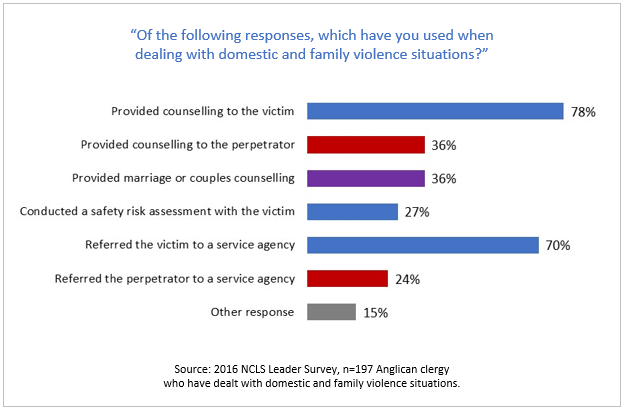
Some 94% of clergy dealt with victims of abuse – by counselling them (78%), referring them to specialist services (70%), and/or much less commonly conducting a safety risk assessment (27%). A large minority of clergy (42%) either counselled perpetrators or referred perpetrators or did both (36% counselled, 24% referred).
Around a third (36%) provided marriage or couples counselling in relation to DFV situations. Couples counselling is problematic. Victims of domestic violence, and services that support them, maintain that couples counselling is ineffective and unsafe as it fails to address the unequal power in an abusive relationship and can place the victim at increased risk.
Referring the victim to a service agency and counselling the victim were the responses that were most often reported in isolation; 38% and 33% respectively of Anglican clergy who reported only one type of response had done so. A similar pattern was observed for clergy who reported one or two types of responses, though the order was reversed; clergy most commonly counselled victims (59%) and referred victims to service agencies (49%). Almost all of those who reported three or more types of response had counselled victims (94%), while 89% referred victims to service agencies.
Responses that were focused on the perpetrator – namely counselling the perpetrator and referring the perpetrator to a service agency – tended not to be reported in isolation, but rather as part of a set of responses. Very small numbers of clergy who reported one or two responses focused on perpetrators. In contrast, among those who reported three or more types of responses 57% had counselled perpetrators while 42% had referred perpetrators to a service agency.
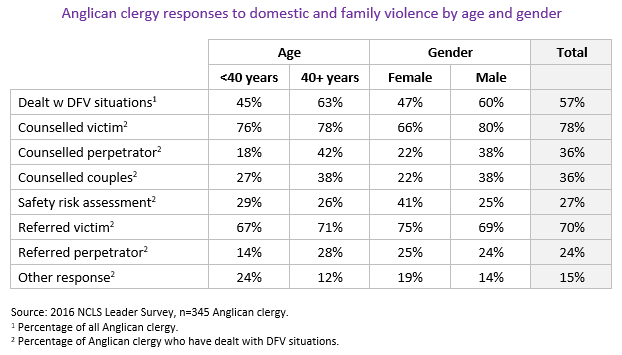
Anglican clergy aged under 40 were significantly less likely than those aged 40 and over to have dealt with DFV situations (45% vs 63%). Among those who had dealt with DFV situations, those aged under 40 were significantly less likely to have dealt with perpetrators (counselling perpetrators and referring perpetrators to services) than those aged 40 and over. Female clergy appear less likely to have provided a range of responses than male clergy, but more likely to have conducted a safety risk assessment with victims. However, the differences by gender are not statistically significant because of low statistical power, due to the small number of female Anglican clergy in the sample.
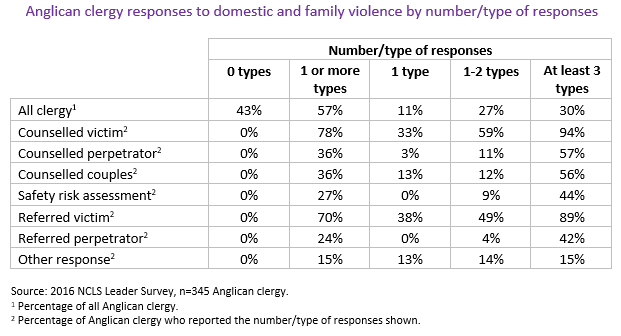
Some 12% of Anglican clergy considered themselves to be very familiar with DFV support services

Forming bridges between churches and specialist DFV support services is an important way to equip clergy to better respond to DFV. While two-thirds of clergy considered themselves to be familiar with local DFV support services at least to some degree (somewhat or very familiar), just 12% considered themselves to be very familiar. Female clergy were significantly more familiar than male clergy with DFV support services. Familiarity did not vary significantly by age.
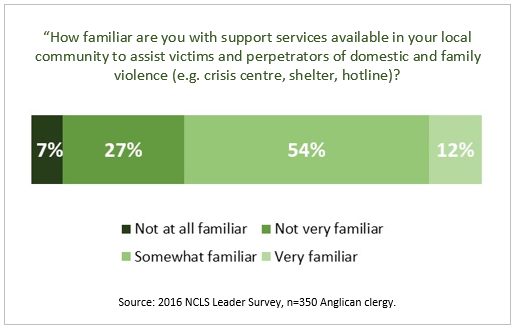
Note: Results are based on n=359 Anglican clergy who participated in the 2016 NCLS. Data are unweighted.
Mean age = 48 years, 80% male, 81% Australian-born, 46% with a postgraduate degree, 65% from the Sydney Diocese. Staff role:
- The minister/pastor/priest of the congregation/parish: 23%
- The senior minister/pastor/priest of ministry team: 22%
- Minister, pastor or priest in a ministry team (not the senior minister): 46%
- Minister/pastor/priest of equal standing in ministry team: 7%
- Interim minister/pastor/priest: 2%
See full paper:
Pepper, Miriam, and Ruth Powell. 2022. "Domestic and Family Violence: Responses and Approaches across the Australian Churches" Religions 13, no. 3: 270. https://doi.org/10.3390/rel13030270



